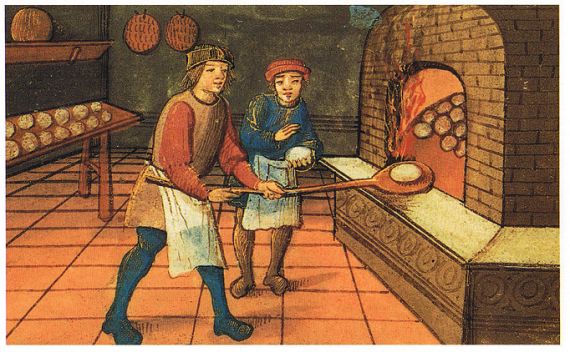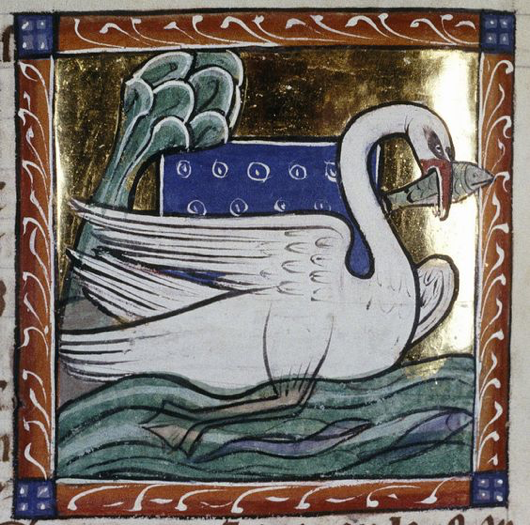Regan Walker
In the course of researching my Medieval Warriors series set in 11th century England and Scotland, I discovered the diet of the time, when not affected by war, was quite varied. While the plants and animals available changed over the course of the era (5th – 15th centuries), we can say much about what they ate, particularly in the Middle Ages. And yes, swan was on the menu, particularly if you were dining with the king, but more about that later.
The roads in medieval England were not good, so the transport of food, save by boat or barge, was limited. Most food was grown and raised locally with the Normans bringing in their own wine. The nobility, for the most part, ate well, and was insulated from shortages. Most estates provided for their needs and they could also bring in additional foodstuffs from the countryside.
Wheat bread, fresh beef, fish, including herring, spices from the Orient and wine were all available to those who could pay. In England, when harvests failed, roots and herbs might be the only food available for peasants. In the later Middle Ages, England’s population living in the rural areas could afford to eat and drink well.
Bread
Bread was a staple and much healthier than most of our breads today. The wealthy preferred the whiter bread made from wheat (“wheaten bread”), but even the highest quality was not actually white, due to the bran, which remained in the flour. More common was bread made from a variety of grains, most often wheat, barley and rye eaten by servants and peasants. Bolton Priory in Yorkshire made “gruel bread” for the poor from a mixture of rye, barley and bean flours. By the 11th century, the baking trade was well established in London. Trenchers that were used like plates were made of hard brown bread. Bread was used for sausages and stuffing, too, and could be sweetened and mixed with eggs, spices (often cinnamon) and currants, for a sweetened dough. Honey was the main sweetener.
Meat & Fish
Depending on where you lived, there might be wild boar, red deer, hares, red squirrel and other creatures in the forests to hunt for food, that is unless they were in a royal forest and you didn’t have the king’s permission to hunt there.
Though the Normans didn’t much favor it, falconry became a popular sport for nobility, and duck might frequently be on the menu as a result. (In my newest medieval novel, Rebel Warrior, the heroine keeps a falcon that hunts duck. King Malcolm has a large mews at Dunfermline, the royal seat, where he keeps his hawks.)
The “royal forests” that began with William the Conqueror designated land on which no one but the king and his cronies could hunt, denying the poor (and others, even the land owner) access to game. In Scotland, you could still hunt in the forests for food without asking the king for permission, at least until the 12th century. Even then, in Scotland the restrictions were much less severe. In both countries, there would be fish in the rivers (salmon and trout, among others) and shellfish and salt-water fish on the coasts.
Meat was cooked by roasting, broiling on a gridiron, frying, boiling and stewing. Feet and ears were made into savory jellies, highly prized in medieval times. Venison was roasted with a strong vinegar and pepper sauce, or salt and cinnamon or powdered ginger.
Domestic cattle, pigs rabbits and chickens were raised for food, but the consumption of meat reflected one’s social class. (Only the lord of the manor in the later medieval era was allowed to construct a rabbit warren attached to the estate.) In the Early Middle Ages, a peasant might not have eaten meat at all, except for a special occasion, or a banquet put on by a lord for his vassals.
From the 13th century onward, monks kept fish and eel ponds. (Eels were popular and cheap, affordable by the poor.) All through the Middle Ages, the poor could afford oysters, which were cheap in comparison with other fish.
By the late 14th and 15th centuries, meat became plentiful. In towns and cities, butchers supplied pork, beef and mutton. Poultry-dealing was a separate trade from the butchers.
Swans have been a tempting food since Biblical times, but in Leviticus 11:18, Israel was prohibited from eating swans because they were considered “unclean,” which is interesting considering that the mute swan was the medieval symbol of love, but that didn’t stop medieval people from eating them.
Hank Shaw, a swan hunter, describes the taste of swan: “Swan is, oddly, more like duck than it is like goose. In fact, the closest thing I can compare it to would be canvasback duck: Dark, tender, mild and clean tasting. It did not have that toughness Canada goose breast can have, nor that beefiness that many geese possess.”
Fruit and Vegetables
Monks and monasteries kept extensive gardens. In kitchen gardens and villagers’ plots, they would grow vegetables for cooking: onions, garlic, red and green cabbages, leeks, radishes, spinach, lettuce, parsnips and turnips. Peas and broad beans were cultivated as field crops.
Carrots, as we know them today, did not come to England until the 15th century. Earlier carrots would have been pale, thin and woody plants, used mostly for their medicinal properties. Ninth and tenth century Viking finds in York, England show carrots, parsnips and turnips, but their vegetables were much more wild than any of our modern varieties. Those carrots would have been white. In fact, early medieval writers often confused them with parsnips, as both plants then appeared similar.
Apples and pears were popular as were summer berries that included strawberries (both wild and cultivate) and cherries. Fruit tarts might be served for dessert with honeyed cakes. Cultivated fruit trees were damsons and bullaces (varieties of plum), mulberries and quinces.
Normans imported spices, foreign herbs and other plants and animals to England to become a part of their feasts. Margaret, Queen of Scots in the late 11th century had been raised in the royal courts of Hungary and King Edward’s England, so that when she married Malcolm, she began importing many things to the royal court in Dunfermline, including foodstuffs and fine cloth.
Bibliography
The Art of Dining: A History of Cooking and Eating by Sara Paston-Williams
The Medieval Cookbook by Maggie Black
Why don’t We Eat Swans Anymore? Monica Kim, May 9 (2014) Modern Farmer blog
On Eating Swans Hank Shaw, December 30 (2013) Honest-Food.net
Regan Walker is an award-winning, bestselling author of Regency, Georgian and Medieval romances. She has five times been featured on USA TODAY’s Happily Ever After blog and four times nominated for the prestigious RONE award (her novel, The Red Wolf’s Prize won Best Historical Novel for 2015 in the medieval category). Regan writes historically authentic novels where history is a character and her readers experience adventure as well as love. Rebel Warrior
was published May 17. There are three books currently in Regan Walker’s Medieval Warriors series and the 4th, King’s Knight, will be out later this year. All three books are available on Amazon.
You can keep up with Regan Walker on her website: www.ReganWalkerAuthor.com
Follow Regan Walker on Twitter: @Regansreview
Like Regan Walker on Facebook: Regan Walker
Regan Walker is also available on Goodreads, Pinterest, and Google+





















Pentru a putea adăuga comentarii trebuie să fii membru al altmarius !
Alătură-te reţelei altmarius